Bremen City Hall
| UNESCO World Heritage Site | |
|---|---|
 City hall from the market place, Roland in side view | |
| Official name | Town Hall and Roland on the Marketplace of Bremen |
| Location | Bremen, Germany |
| Criteria | Cultural: (iii), (iv), (vi) |
| Reference | 1087 |
| Inscription | 2004 (28th Session) |
| Area | 0.287 ha (0.00111 sq mi) |
| Buffer zone | 376 ha (1.45 sq mi) |
| Website | www |
| Coordinates | 53°4′33.5″N 8°48′26.9″E / 53.075972°N 8.807472°E |
Bremen City Hall (German: Bremer Rathaus) is the seat of the President of the Senate and Mayor of Bremen, Germany. It is one of the most important examples of Brick Gothic and Weser Renaissance architecture in Europe. Since 1973, it has been a protected historical building.[1] In July 2004, along with the Bremen Roland statue, the building was added to the list of UNESCO World Heritage Sites because of its outstanding architecture and its testimony to the development of civic autonomy in the Holy Roman Empire.[2]
Location and description
The city hall is on the northeastern side of the
The old town hall itself, originally constructed in the 15th century, is a rectangular, two-storey hall measuring 41.5 by 15.8 m.[2] The ground floor contains one large hall with oak pillars, historically used for merchants and theatre, and the upper floor contained the main festivity hall.[2]
History
The ancient town hall
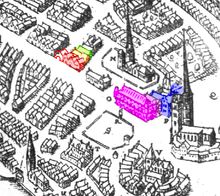
pink = Gothic town hall
blue = archbishop's palace
red = adaptions or descessors of the ancient town hall
red outline = dismantled arch,[3]
green = descessor buildings of the ancient office
yellow = probable other relics or descessors of the ancient town hall group
Bremen's original town hall had been situated in the southern end of the block between Liebfrauenkirchhof ("Our Dear Lady's Churchyard"), Obernstraße ("Highstreet") and Sögestraße ("Pigstreet"). In 1229, it was mentioned as "domus theatralis" ("show house"), since 1251 repeatedly as "domus consularis" ("councilars' house"). An arch across the Sögestraße and a repair by a mason suggest a stone building, and already existing before the arrival of Gothic style it must have been erected in Romanesque style. It is assumed that before the municipality gained a certain autonomy, the building served as a law court and therefore had at least one open hall, as old Saxon law forbade trials to be held in closed rooms. An exact description is not available, but several documents tell about the cloth shops in that location. They describe the locations of "sub" ("below") being the town hall and the office. Depending on the interpretation of "below" as "in the hall below …" or "in front of the basement of …", the documents suggest very different settings of the town hall and its environment. Two texts tell of a stair or staircase of the house at Liebfrauenkirchhof.
After the construction of the newer town hall, it was hired out to the grocers' guild, than as a hobs store. Finally in 1598, it was sold to two owners, who converted it to or replaced it as their private houses.
The Gothic town hall
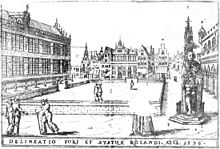
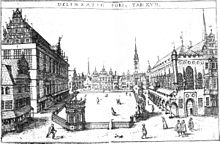
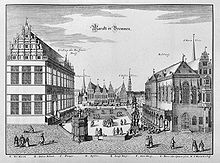
Around 1400, when the development of Bremen was at its height, a new town hall was planned and built. Most engaged were
With the construction of the town hall, the first Roland sculpture was erected in front of it. It was not yet as large as today.
The town hall in
On the rear side of the Gothic town hall, there was an extension, on the upper floor containing the room for the city council, called Altes Wittheits-Stube, (The Old Council Chamber). West of it, there was an outer staircase from Our Dear Lady's Churchyard to the upper hall.
After the Rebellion of the 104 Men in 1432, the outer staircase was removed. At the end of 15th century, an office was built below the old Wittheits-Stube.
Renaissance
From 1545 to 1550, an extension with three floors, containing a new Wittheits-Stube and offices, was built between the town hall and the archbishop's palace, showing a Renaissance style gable eastward facing the cathedral.
In the end of the century, Bremen lived through its second boom, and a great relaunch of the town hall was headed. The main artist was the architect and mason
Baroque


Soon after the completion of those works, Germany was ravaged by the Thirty Years' War, and after the Peace of Westphalia, Bremen had to defend against Swedish the invasion.
In 1682/83, The office on the rear side was enlarged in a form of Baroque style – with horizontal rows of windows that did not become common two centuries later.
19th century
With the
20th century

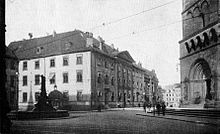
From 1820 to 1900, Bremen multiplied its population, and, in the decades around 1900,
By boarding up the outer walls, and due to heroic efforts of the fire brigade, the town hall of Bremen survived the air raids of World War II with little damage, though more than sixty percent of the city was destroyed.
Usage
- As mentioned above, the seat of the Burgomaster of Bremen is in the New Town Hall.
- The Bremer Schaffermahlzeit a traditional annual banquet for the captains, is held in the banquet hall of the New Town Hall.
- Many ceremonial events are held in the upper hall of the Old Town Hall.
- The lower hall of the historical building is frequently used for exhibitions.
Main sights

Old Town Hall
- The Upper Hall (Obere Rathaushalle). It is still Bremen's official for meetings.
- The Golden Chamber (Güldenkammer). This small room, added to the upper hall in 1608, was redecorated in 1905 by cuir de Cordoue) have been selected in this style.
- The Lower Hall (Untere Rathaushalle). This room retains its unadorned original form. In contrast to the upper chamber, this room is much simpler, with a stone floor, visible timber beams, and whitewashed walls. In earlier times, it also functioned as a marketplace for fine-goods such as spices and cloths. Nowadays it is used for exhibitions.
- The Bremer Ratskeller is a public house in the basement, the home of the oldest barrel of wine in Germany, crafted in 1653.
New Town Hall
- The banquet hall
- The fireplace room
- The Gobelin room
- The Senate Hall
Gallery
-
Roland sculpture
-
Neighbourhood of Bremen's town hall
-
Upper Hall
-
Upper Hall with former archive (upstairs) and Güldenkammer
-
Upper Hall, "Charlemagne and bishop Ansgar", painted in 1532
-
Lower Hall
-
Fireplace in the New Town Hall
Sources
- Konrad Elmshäuser: Der erste Roland und das erste Rathaus von Bremen, In: Bremisches Jahrbuch, vol. 84, Bremen 2005, ISSN 0341-9622, p. 9–45
- Rudolf Stein: Romanische, gotische und Renaissancebaukunst in Bremen, Bremen 1962, p. 239–276 und 529–676
References
- ^ "Database of Landesamt für Denkmalpflege Bremen #0066,T0001". (in German)
- ^ a b c "Town Hall and Roland on the Marketplace of Bremen". UNESCO World Heritage Centre. UNESCO. Retrieved 3 September 2022.
- ^ drawn after the topographically quite incorrect map by Frans Hogenberg
External links
- City of Bremen official website – in German and English
- Town Hall and Roland on the Marketplace of Bremen – UNESCO website










